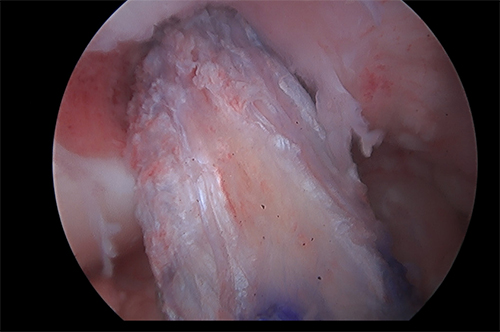
Amit Momaya, MD
Published on: January 17, 2023
There are several graft options to consider for ACL surgery. One must first think about using tissue from your own body (autograft) versus tissue from a decreased donor (allograft). An autograft is typically used for younger patients who will place greater demand on their knees. An allograft is reserved for slightly older patients who have lower demands on the knee or need an easier recovery due to work or family obligations. Among autograft options, the most common are patellar tendon, quadriceps tendon, and hamstring. Recent studies have shown that hamstring tendons, when used for ACL reconstruction, may fail at a slightly higher rate. The patellar tendon has long been used in professional sports leagues in the United States. However, the quadriceps tendon is growing exponentially in use.

Figure 1 demonstrates a quadriceps tendon after it has been harvested.

Figure 2 shows the quad tendon ACL via an arthroscope.
Let’s discuss the top 3 reasons you should consider the quad tendon for your ACL.
- The quad tendon is thick. In fact, the quad tendon has 20% more collagen per cross sectional area than the patellar tendon. In addition, the ultimate load to failure of a 10 mm quad tendon is almost 30% higher than a 10 mm wide patellar tendon.
Figure 3 demonstrates the thickness of a quadriceps tendon compared to the patellar tendon on MRI.
- Quadriceps tendon is a versatile graft. One can use it for adults in addition to kids who are skeletally immature. The surgeon has the ability to pick the length (in terms of how much is cut) for an all soft tissue quadriceps tendon. For adults, we typically cut 70 mm and for skeletally immature kids, we cut somewhere around 50-55 mm. The patellar tendon, in contrast, has a pre-determined length due to the bone blocks that are harvested with the patellar tendon. Thus, you may have “excess” patellar tendon cut and harvested. In addition, bone blocks should be avoided in skeletally immature kids who may be at risk for growth plate arrest.
- Quadriceps tendon autografts have similar outcomes and retear rates compared to patellar tendon grafts. However, the quad tendon ACLs showed significantly less harvest site pain compared to patellar tendon ACLs. A recent study highlighted these findings.
The video below demonstrates the graft prep for a quadriceps tendon.
This next video demonstrates the passage of a quad tendon ACL into the femoral and tibial tunnels. The graft has been augmented with an internal brace in this case.
Graft choices should be individualized to the patient. Both the quad tendon and the patellar tendon are appropriate graft choices for ACL surgery, and Dr. Momaya discusses both options with his patients.









